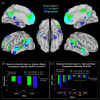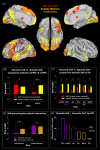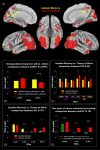Bipartite Functional Fractionation within the Default Network Supports Disparate Forms of Internally Oriented Cognition
- PMID: 32494802
- PMCID: PMC7472201
- DOI: 10.1093/cercor/bhaa130
Bipartite Functional Fractionation within the Default Network Supports Disparate Forms of Internally Oriented Cognition
Abstract
Our understanding about the functionality of the brain's default network (DN) has significantly evolved over the past decade. Whereas traditional views define this network based on its suspension/disengagement during task-oriented behavior, contemporary accounts have characterized various situations wherein the DN actively contributes to task performance. However, it is unclear how different task-contexts drive componential regions of the DN to coalesce into a unitary network and fractionate into different subnetworks. Here we report a compendium of evidence that provides answers to these questions. Across multiple analyses, we found a striking dyadic structure within the DN in terms of the profiles of task-triggered fMRI response and effective connectivity, significantly extending beyond previous inferences based on meta-analysis and resting-state activities. In this dichotomy, one subset of DN regions prefers mental activities "interfacing with" perceptible events, while the other subset prefers activities "detached from" perceptible events. While both show a common "aversion" to sensory-motoric activities, their differential preferences manifest a subdivision that sheds light upon the taxonomy of the brain's memory systems. This dichotomy is consistent with proposals of a macroscale gradational structure spanning across the cerebrum. This gradient increases its representational complexity, from primitive sensory-motoric processing, through lexical-semantic representations, to elaborated self-generated thoughts.
Keywords: connectivity; default-mode network; memory; semantic cognition; topography.
© The Author(s) 2020. Published by Oxford University Press.
Figures







Similar articles
-
Distinctive and Complementary Roles of Default Mode Network Subsystems in Semantic Cognition.J Neurosci. 2024 May 15;44(20):e1907232024. doi: 10.1523/JNEUROSCI.1907-23.2024. J Neurosci. 2024. PMID: 38589231 Free PMC article.
-
A gradient from long-term memory to novel cognition: Transitions through default mode and executive cortex.Neuroimage. 2020 Oct 15;220:117074. doi: 10.1016/j.neuroimage.2020.117074. Epub 2020 Jun 20. Neuroimage. 2020. PMID: 32574804 Free PMC article.
-
Both Default and Multiple-Demand Regions Represent Semantic Goal Information.J Neurosci. 2021 Apr 21;41(16):3679-3691. doi: 10.1523/JNEUROSCI.1782-20.2021. Epub 2021 Mar 4. J Neurosci. 2021. PMID: 33664130 Free PMC article.
-
The default mode network in cognition: a topographical perspective.Nat Rev Neurosci. 2021 Aug;22(8):503-513. doi: 10.1038/s41583-021-00474-4. Epub 2021 Jul 5. Nat Rev Neurosci. 2021. PMID: 34226715 Review.
-
How does the "default mode" network contribute to semantic cognition?Brain Lang. 2024 May;252:105405. doi: 10.1016/j.bandl.2024.105405. Epub 2024 Apr 4. Brain Lang. 2024. PMID: 38579461 Free PMC article. Review.
Cited by
-
Nodes of the default mode network implicated in the quality of empathic responses: A clinical perspective of the empathic response.Int J Clin Health Psychol. 2023 Jan-Apr;23(1):100319. doi: 10.1016/j.ijchp.2022.100319. Epub 2022 Sep 16. Int J Clin Health Psychol. 2023. PMID: 36168601 Free PMC article.
-
A synergistic workspace for human consciousness revealed by Integrated Information Decomposition.Elife. 2024 Jul 18;12:RP88173. doi: 10.7554/eLife.88173. Elife. 2024. PMID: 39022924 Free PMC article.
-
A middle ground where executive control meets semantics: the neural substrates of semantic control are topographically sandwiched between the multiple-demand and default-mode systems.Cereb Cortex. 2023 Apr 4;33(8):4512-4526. doi: 10.1093/cercor/bhac358. Cereb Cortex. 2023. PMID: 36130101 Free PMC article.
-
A tale of two gradients: differences between the left and right hemispheres predict semantic cognition.Brain Struct Funct. 2022 Mar;227(2):631-654. doi: 10.1007/s00429-021-02374-w. Epub 2021 Sep 12. Brain Struct Funct. 2022. PMID: 34510282 Free PMC article.
-
Task-specific network interactions across key cognitive domains.Cereb Cortex. 2022 Nov 9;32(22):5050-5071. doi: 10.1093/cercor/bhab531. Cereb Cortex. 2022. PMID: 35158372 Free PMC article.
References
-
- Andreasen NC, O'leary DS, Cizadlo T, Arndt S, Rezai K, Watkins GL, Boles Ponto LL, Hichwa RD. 1995. Remembering the past: two facets of episodic memory explored with positron emission tomography. Am J Psychiatry. 152:1576–1585. - PubMed
Publication types
MeSH terms
Grants and funding
LinkOut - more resources
Full Text Sources
Miscellaneous

